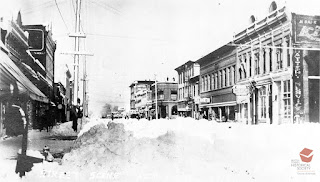The newest Benton County Historical Museum's exhibition,
Circa 1920-- Roaring into the Modern Age, is now open in the downstairs
gallery. You'll learn about events from
the period 1914 to 1925 which affected local residents. You'll also see changes in fashion, music,
art, and household operation.
What was Benton County like at the start of this
period? According to the 1910 U. S.
Census, Benton County had 10,663 residents, most of whom (93%) were native-born
whites. Men (5729) outnumbered women (4934).
Here's a photographic tour of the county in the early 1900s.
Corvallis was the largest city, with 4,552 residents, or 43%
of the county's population. The photo looks north along 2nd Street.
 |
| Corvallis, Oregon |
Philomath, with 505 residents, was the second largest incorporated
city. In 1914, as now, Marys Peak dominated the skyline to the west.
 |
| Philomath and Marys Peak, Benton County, Oregon |
 |
| Monroe, Oregon |
A number of other small groupings of homes scattered across
the county. Some were in King's Valley.
 |
| Kings Valley, Oregon |
In spite of being home to 2 colleges, Oregon Agricultural
College (now Oregon State University) and Philomath College, Benton County was
largely agricultural. This 1915 photo
shows the McClelland Farm just west of Philomath.
Come to the museum to see some additional photographs of
Benton County's cities. I will also feature other period photographs in future
posts.
By
Martha Fraundorf, Volunteer for Benton County Historical Society, Philomath,
Oregon







